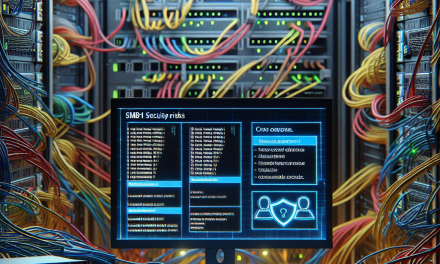In an era where cybersecurity threats are becoming increasingly sophisticated, organizations must prioritize endpoint forensics on their Windows Server environments. Understanding how to effectively analyze these endpoints can be crucial for identifying breaches, understanding attack vectors, and enhancing overall security posture. This article outlines best practices and techniques for conducting an effective forensic analysis on Windows Server endpoints, specifically tailored for WafaTech Blogs.
Why Endpoint Forensics Matters
Endpoint forensics refers to the process of collecting, preserving, and analyzing data from endpoint devices to investigate security incidents. For Windows Servers, this could mean analyzing user activity, system logs, file changes, network traffic, and more. The insights gained can help organizations:
- Identify vulnerabilities and attack vectors.
- Document incidents for legal and compliance needs.
- Implement more robust security measures.
- Enhance employee training to prevent future incidents.
Best Practices for Windows Server Endpoint Forensics
1. Establish a Forensic Readiness Plan
Before incidents occur, create a forensic readiness plan that outlines policies, procedures, and tools for responding to security incidents. This plan should include:
- Identification of critical systems and data.
- Collection procedures that ensure evidence integrity.
- Documentation standards for maintaining a clear chain of custody.
2. Use Appropriate Forensics Tools
Utilize specialized forensic tools that cater to Windows Server environments. Some popular options include:
- FTK Imager: For creating disk images and analyzing file systems.
- WinDbg: For analyzing memory dumps.
- Sysinternals Suite: Offers a variety of utilities to monitor system activity.
3. Monitor and Log System Activity
Enable comprehensive logging on Windows Server to capture important events. Use the following logging techniques:
- Windows Event Logs: Configure the event log policies to include login attempts, file access, and system changes.
- Audit Policy Enforcements: Implement audit policies to keep track of sensitive operations, such as changes to user permissions or group memberships.
4. Maintain System Integrity
Regularly update your system and applications to patch known vulnerabilities. Additionally, implement integrity monitoring tools, which check for unauthorized changes to critical files and registry entries.
5. Secure Backup Procedures
Maintain a secure backup solution to ensure that you can restore systems to a previous state without loss of data. Ensure that backups are:
- Isolated from the network to prevent ransomware attacks.
- Regularly tested to ensure their efficacy.
Techniques for Analyzing Windows Server Endpoints
1. Analyzing Windows Event Logs
Windows Event Logs are an invaluable resource. Key logs to analyze include:
- Security Logs: For tracking authentication attempts and user actions.
- Application Logs: To identify potential exploitation of software vulnerabilities.
- System Logs: To uncover hardware or driver-related issues that may indicate intrusion.
2. File System Analysis
Review file and folder timestamps, security descriptors, and file hashes to identify any unusual changes. Use tools like PowerShell scripts for automated checks on file integrity and modifications.
3. Network Traffic Analysis
Monitor network traffic using tools like Wireshark or Microsoft Message Analyzer to identify anomalies. Look for unusual outbound connections or data exfiltration patterns.
4. Memory Analysis
In cases of suspected malware or rootkits, memory analysis can reveal hidden processes or injected code. Tools like Volatility Framework can assist in extracting essential information from memory dumps.
5. User Behavior Analytics
Implement User Behavior Analytics (UBA) to track user actions on the server. Anomalies in user behavior can indicate compromised accounts or insider threats.
Documenting Your Findings
After completing your analysis, compile your findings into a comprehensive report that includes:
- Background information on the incident.
- Analysis results, including evidence collected.
- Recommendations for mitigation and future prevention.
Ensure that this report is clear and supports any necessary incident response actions, legal proceedings, or compliance audits.
Conclusion
Effective endpoint forensics on Windows Server can significantly enhance an organization’s ability to respond to cybersecurity threats. By implementing best practices and utilizing robust forensic techniques, IT teams can gain valuable insights that not only address immediate concerns but also contribute to a more secure environment in the long run. Staying proactive is vital; the investment in forensics will pay dividends in safeguarding against increasingly complex cyber threats.
For more insights into Windows Server management and security best practices, stay tuned to WafaTech Blogs!





